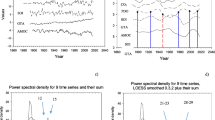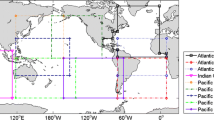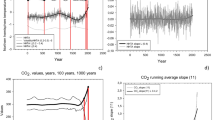Abstract
Cycle times found in many oceanic time series have been explained with references to external mechanisms that act on the systems. Here we show that when we extract cycle times from 100 sets of paired random series, we find six distinct clusters of common cycle times ranging from about 3 years to about 32 years. Cycle times, CT, get shorter when one series in a pair is an increasingly stronger leading series to the other, CT ≈ −(minus) LL-strength. This may explain the frequent finding that many global warming time series, e.g., the Southern oscillation index and the Pacific decadal oscillation, show distinct cycle times (Power spectral analysis: 3–5, 7–8, 13–15, 22–24, and 29–30 years). An important implication of these findings is that processes that strengthen the impact of one ocean variable on another may cause more frequent adverse climate conditions.




Similar content being viewed by others
Notes
With x-coordinates in A1 to A3 and y-coordinates in B1 to B3 the angle is calculated by pasting the following Excel expression into C2: = SIGN((A2 − A1) × (B3 − B2) − (B2 − B1) × (A3 − A2)) × ACOS(((A2 − A1) × (A3 − A2) + (B2 − B1) × (B3 − B2))/(SQRT((A2 − A1)2+(B2 − B1)2) × SQRT((A3 − A2)2+(B3 − B2)2))).
References
Allan RJ, D’Arrigo RD (1999) “‘Persistent’ ENSO sequences: how unusual was the 1990–1995 El Nino?” Holocene 9(1):101–118
Amaya DJ, Xie SP, Miller AJ, McPhaden MJ(2015) Seasonality of tropical Pacific decadal trends associated with the 21st century global warming hiatus. J Geophys Res-Oceans 120(10):6782–6798.
Andrews MB, Knight JR and Gray LJ (2015) A simulated lagged response of the North Atlantic Oscillation to the solar cycle over the period 1960–2009. Environ Res Lett 10(5):054022.
Bayer D, Diaconis P (1992) Trailing the dovetail shuffle to its lair. Ann Appl Probab 2(2):294–313.
Cai WJ, Wang GJ, Santoso A, McPhaden MJ, Wu LX, Jin FF, Timmermann A, Collins M, Vecchi G, Lengaigne M, England MH, Dommenget D, Takahashi K, Guilyardi E (2015) Increased frequency of extreme La Nina events under greenhouse warming. Nat Climate Change 5(2):132–137
Capotondi A, Wittenberg AT, Newman M, Di Lorenzo E, Yu JY, Braconnot P, Cole J, Dewitte B, Giese B, Guilyardi E, Jin FF, Karnauskas K, Kirtman B, Lee T, Schneider N, Xue Y, Yeh SW (2015) Understanding ENSO Diversity. Bull Am Meteorol Soc 96(6):921–938
Chylek P, Dubey MK, Lesins G, Li JN, Hengartner N (2014) Imprint of the Atlantic multi-decadal oscillation and Pacific decadal oscillation on southwestern US climate: past, present, and future. Clim Dyn 43(1–2):119–129
DelSole T, Tippett MK, Shukla J (2011) A significant component of unforced multidecadal variability in the recent acceleration of global warming. J Clim 24(3):909–926
Di Lorenzo E, Liguori G, Schneider N, Furtado JC, Anderson BT, Alexander MA (2015) ENSO and meridional modes: A null hypothesis for Pacific climate variability. Geophys Res Lett 42(21):9440–9448
Fedorov AV, Hu SN, Lengaigne M, Guilyardi E (2015) The impact of westerly wind bursts and ocean initial state on the development, and diversity of El Nino events. Clim Dyn 44(5–6):1381–1401
Finlay K, Vogt RJ, Bogard MJ, Wissel B, Tutolo BM, Simpson GL, Leavitt PR (2015) Decrease in CO2 efflux from northern hardwater lakes with increasing atmospheric warming. Nature 519(7542):215–218
Flugel M, Chang P (1999) Stochastically induced climate shift of El Nino-Southern Oscillation. Geophys Res Lett 26(16):2473–2476
Gehne M, Kleeman R, Trenberth KE (2014). Irregularity and decadal variation in ENSO: a simplified model based on Principal Oscillatory Petterns. Clim Dyn 43:3327–3350
Keeling CD, Whorf TP (1997) Possible forcing of global temperature by oceanic tides. Proc Natl Acad Sci USA 94:8321–8328
Kestin TS, Karoly DJ, Yang JI, Rayner NA (1998) Time–frequency variability of ENSO and stochastic simulations. J Clim 11(9):2258–2272
Liu BQ, Wu GX, Ren RC (2015) Influences of ENSO on the vertical coupling of atmospheric circulation during the onset of South Asian summer monsoon. Clim Dyn 45(7–8):1859–1875
Mann B (1994). How many times should you shuffle a deck of cards? UMAP J 4:303–332.
McCarthy GD, Haigh ID, J. J. M. Hirschi, Grist JP, Smeed DA (2015) Ocean impact on decadal Atlantic climate variability revealed by sea-level observations. Nature 521(7553):508–510
McPhaden MJ (2015) COMMENTARY: playing hide and seek with El Nino. Nat Clim Change 5(9):791–795
Meehl GA, Arblaster JM, Matthes K, Sassi F, van Loon H (2009) Amplifying the Pacific climate system response to a small 11-year solar cycle forcing. Science 325(5944):1114–1118
Meehl GA, Hu AX, Arblaster JM, Fasullo J, Trenberth KE (2013) Externally forced and internally generated decadal climate variability associated with the interdecadal Pacific oscillation. J Clim 26(18):7298–7310
Meehl GA, Teng HY, Arblaster JM (2014) Climate model simulations of the observed early-2000s hiatus of global warming. Nature. Clim Change 4(10):898–902
Moore SK, Mantua NJ, Kellogg JP, Newton JA (2008) Local and large-scale climate forcing of Puget Sound oceanographic properties on seasonal to interdecadal timescales. Limnol Oceanogr 53(5):1746–1758
Munk W, Dzieciuch M, Jayne S (2002) Millennial climate variability: Is there a tidal connection? J Clim 15(4):370–385
Newman M, Shin S-I, Alexander MA (2011) Natural variation in ENSO flavors. Geophys Res Lett 38:L14705. doi:10.1029/2011GL047658
Press WH, Flannery BP, Teukolsky SA, Vettering WT (1986) Numerical recipes. The art of scientific computing. Cambridge university press, Cambridge
Ray RD (2007) Decadal climate variability: Is there a tidal connection? J Clim 20(14):3542–3560
Santoso A, Cai WJ, Collins M, McPhaden M, Jin FF, Guilyardi E, Vecchi G, Dommenget D, Wang GJ (2015) ENSO extremes and diversity. Dynamics, teleconnections, and impacts. Bull Am Meteorol Soc 96(11):1969–1972
Seip KL (2015) Investigating possible causal relations among physical, chemical and biological variables across regions in the Gulf of Maine. Hydrobiologia 744:127–143
Seip KL, Grøn Ø (2015) A new method for identifying possible causal relationships between CO2, total solar irradiance and global temperature change. Theor Appl Climatol. doi:10.1007/s00704-015-1675-8
Seip KL, Sas H, Vermij S (1990) The short term response to eutrophication abatement. Aquat Sci 52:199–220
Takahashi K, Dewitte B (2016) Strong and moderate nonlinear El Nino regimes. Clim Dyn 46(5–6):1627–1645
Timmermann A, Oberhuber J, Bacher A, Esch M, Latif M, Roeckner E (1999) Increased El Nino frequency in a climate model forced by future greenhouse warming. Nature 398(6729):694–697
Tourre YM, Rajagopalan B, Kushnir Y, Barlow M, White WB (2001) Patterns of coherent decadal and interdecadal climate signals in the Pacific Basin during the 20th century. Geophys Res Lett 28(10):2069–2072
Trenberth KE (2015) Has there been a hiatus? Science 349(6249):691–692
Wunsch C (1999) The interpretation of short climate records, with comments on the North Atlantic and Southern Oscillations. Bull Am Meteorol Soc 80(2):245–255
Wunsch C (2000) On sharp spectral lines in the climate record and the millennial peak. Paleoceanography 15(4):417–424
Zhu J, Zhou G, Zhang RH, Sun Z (2011) On the role of oceanic entrainment temperature (T-e) in decadal changes of El Nino/Southern Oscillation. Ann Geophys 29(3):529–540
Acknowledgements
We thank the University college of Oslo and Akershus for applied sciences for supporting our study and Shineng Hu for supplying us with data for Fig. 11b in Fedorov et al. (2015).
Author information
Authors and Affiliations
Corresponding author
Ethics declarations
Conflict of interest
There is no competing financial interests for any of the authors.
Additional information
This paper is a contribution to the special collection on ENSO Diversity. The special collection aims at improving understanding of the origin, evolution, and impacts of ENSO events that differ in amplitude and spatial patterns, in both observational and modeling contexts, and in the current as well as future climate scenarios. This special collection is coordinated by Antonietta Capotondi, Eric Guilyardi, Ben Kirtman and Sang-Wook Yeh.
Electronic supplementary material
Below is the link to the electronic supplementary material.
Rights and permissions
About this article
Cite this article
Seip, K.L., Grøn, Ø. On the statistical nature of distinct cycles in global warming variables. Clim Dyn 52, 7329–7337 (2019). https://doi.org/10.1007/s00382-016-3508-6
Received:
Accepted:
Published:
Issue Date:
DOI: https://doi.org/10.1007/s00382-016-3508-6




